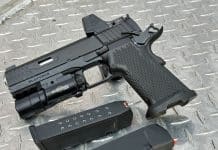A Russian Ka-52 Alligator crashed on 12 March during a training exercise in the Tver region. Although the cause of the crash is as yet unknown, one pilot died at the scene and the other succumbed to his injuries the next day. This is the first crash of a Ka-52.
The Ka-52 is a variant of the Ka-50 (NATO designation Hokum), which entered service in 2009 after being eclipsed by the Mi-28 (NATO designation Havoc) and having the funding for the first 12 units cut in 2005. The Ka-50 Black Shark saw combat action in Chechnya and was praised for its utility as a scout, attack, and command platform.
The Ka-52 is a two-seat version of the single-seat Ka-52. Unlike modern attack helicopters such as the AH-64 Apache, the Ka-52 uses side-by-side seats. This reduces speed slightly (about 10 kph), increases fuel consumption, and reduces capacity for armor and ordnance—total loadout for the helicopter’s 2A42 30mm cannon is 240 rounds versus 470 in the Ka-50. However, the configuration improves visibility and coordination, especially when the Ka-52 is employed in a command and control role.
The Alligator has a total of six hardpoints—two wingtip and four underwing—that can mount a variety of weapon systems. Options include the Igla-V (SA-18) air-to-air missile, the 9K121 Vikhr (AT-16) anti-tank missile, and the B8V-20 80mm rocket pod containing 20 rounds. Fuel tanks and electronic countermeasures (ECM) pods can also be equipped.
Exactly what sensors the Ka-52 carries is still unclear, but the mix is likely to include optical and infrared sights, a laser rangefinder, and a forward-looking infrared (FLIR) pod. Mast-mounted sensors like those found on the U.S. Kiowa and Longbow helicopters have also been reported.
The director of the state-run military contractor Oboronprom confirmed in September 2011 that a naval variant, the Ka-52K, is in development for use on Russia’s new French-built Mistral-class amphibious warfare ships. Deployment is expected by the end of 2012.












